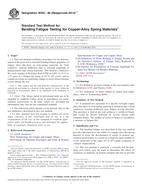We need your consent to use the individual data so that you can see information about your interests, among other things. Click "OK" to give your consent.
ASTM B593-96(2014)e1
Standard Test Method for Bending Fatigue Testing for Copper-Alloy Spring Materials (Includes all amendments And changes 4/7/2020).
Automatically translated name:
Standard Test Method for Bending Fatigue Testing for Copper-Alloy Spring Materials
STANDARD published on 1.4.2009
The information about the standard:
Designation standards: ASTM B593-96(2014)e1
Note: WITHDRAWN
Publication date standards: 1.4.2009
SKU: NS-7315
The number of pages: 5
Approximate weight : 15 g (0.03 lbs)
Country: American technical standard
Category: Technical standards ASTM
The category - similar standards:
Annotation of standard text ASTM B593-96(2014)e1 :
Keywords:
bending fatigue, bending fatigue testing, copper alloy flat strip, copper alloy spring, fatigue testing, ICS Number Code 77.150.30 (Copper products)
Additional information
| Significance and Use | ||||||||||
|
The bending fatigue test described in this test method provides information on the ability of a copper alloy flat-spring material to resist the development of cracks or general mechanical deterioration as a result of a relatively large number of cycles (generally in the range 105 to 108) under conditions of constant displacement. This test method is primarily a research and development tool which may be used to determine the effect of variations in materials on fatigue strength and also to provide data for use in selecting copper alloy spring materials for service under conditions of repeated strain cycling. The results are suitable for direct application in design only when all design factors such as loading, geometry of part, frequency of straining, and environmental conditions are known. The test method is generally unsuitable for an inspection test or a quality control test due to the amount of time and effort required to collect the data. |
||||||||||
| 1. Scope | ||||||||||
|
1.1 This test method describes procedures for the determination of the reversed or repeated bending fatigue properties of copper alloy flat-sheet or strip-spring materials by fixed cantilever, constant deflection (that is, constant amplitude of displacement)-type testing machines. This method is limited to flat stock ranging in thickness from 0.005 to 0.062 in. (0.13 to 1.57 mm), to a fatigue-life range of 105 to 108 cycles, and to conditions where no significant change in stress-strain relations occurs during the test. Note 1—This implies that the load-deflection characteristics of the material do not change as a function of the number of cycles within the precision of measurement. There is no significant cyclic hardening or softening. 1.2 Units—The values stated in inch-pound units are to be regarded as standard. The values given in parentheses are mathematical conversions to SI units that are provided for information only and are not considered standard. 1.3 The following safety hazard caveat pertains only to the test methods(s) described in this test method. 1.3.1 This standard does not purport to address all of the safety concerns, if any, associated with its use. It is the responsibility of the user of this standard to establish appropriate safety and health practices and determine the applicability of regulatory limitations prior to use. |
||||||||||
| 2. Referenced Documents | ||||||||||
|



 Cookies
Cookies
